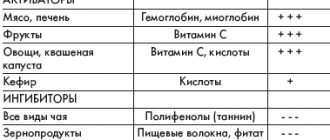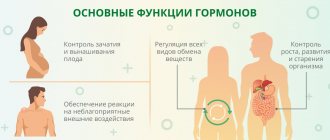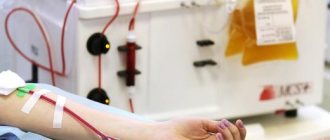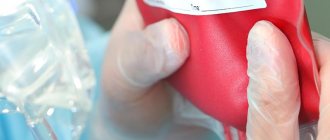Preparing for the examination
To obtain reliable results for the study, it is necessary to follow the preparation rules. For two or three days before donating blood, it is necessary to exclude serious physical activity and stressful situations. You should not drink alcohol, fatty foods, or foods that are difficult to digest. On the eve of visiting the laboratory, you should have a light dinner, do not overuse coffee and strong tea. The last meal occurs no later than 8-12 hours before blood donation. You cannot smoke 2-3 hours before.
If the patient is taking any medications, you need to inform the doctor who referred you for liver tests.
Factors that influence the results of the analysis:
- failure to follow recommendations for preparing for blood donation;
- the patient is overweight;
- taking certain medications;
- following a vegetarian diet;
- pregnancy;
- prolonged application of a tourniquet when drawing blood.
What are the indications for the liver profile?
If you pay close attention to your health, you are interested in monitoring your liver health. For preventive purposes, a liver profile can be done once a year. But, before you go for tests, you should know what the indications for the liver profile are.
First of all, the liver profile is recommended for people taking toxic medications, as well as those with chronic liver diseases. This also applies to people suffering from alcohol or chemical dependence.
The analysis can also be prescribed to a person who has external signs of damage to the liver or gallbladder, expressed in a yellow tint of the skin and mucous membranes, abdominal pain, nausea and vomiting.
A comprehensive laboratory examination of the liver, allowing to assess its main functions and indicators of protein, carbohydrate, fat and pigment metabolism.
The examination results are issued with a doctor’s interpretation.
Synonyms Russian
- Tests to evaluate liver function
- Liver disease screening
English synonyms
- Laboratory liver panel
- Liver function tests
- Liver check-up
Research method
- Coagulogram No. 1 (prothrombin (according to Quick), INR) – method of detecting side light scattering, determining the percentage by end point
- Alanine aminotransferase (ALT) – UV kinetic test
- Serum Albumin – BCG Method (Bromocresol Green)
- Aspartate aminotransferase (AST) - UV kinetic test
- Gamma-glutamyl transpeptidase (gamma-GT) – kinetic colorimetric method
- Total bilirubin – colorimetric photometric method
- Direct bilirubin – colorimetric photometric method
- Total alkaline phosphatase – colorimetric photometric method
- Total cholesterol - colorimetric photometric method
- Indirect bilirubin – colorimetric photometric method
- Bilirubin and its fractions (total, direct and indirect) - colorimetric photometric method
Units
- Coagulogram No. 1 (prothrombin (according to Quick), INR) – % (percent), sec. (seconds)
- Alanine aminotransferase (ALT) – U/L (unit per liter)
- Serum albumin – g/l (grams per liter)
- Aspartate aminotransferase (AST) – U/L (unit per liter)
- Gamma-glutamyl transpeptidase (gamma-GT) – U/L (unit per liter)
- Total bilirubin – µmol/l (micromoles per liter)
- Direct bilirubin – µmol/l (micromol per liter)
- Total alkaline phosphatase – U/l (unit per liter)
- Total cholesterol – mmol/l (millimoles per liter)
- Indirect bilirubin – µmol/l (micromol per liter)
- Bilirubin and its fractions (total, direct and indirect) – µmol/l (micromoles per liter)
What biomaterial can be used for research?
Venous blood.
How to properly prepare for research?
- Do not eat for 12 hours before the test.
- Avoid physical and emotional stress for 30 minutes before the test.
- Do not smoke for 30 minutes before the test.
General information about the study
The liver is the largest gland in the human body. This organ performs about 5,000 different functions. Basic liver functions can be assessed using a comprehensive laboratory test.
1. Synthetic liver function
- Albumin is the main blood protein that performs a transport function and ensures the maintenance of oncotic pressure. When the synthetic function of the liver is impaired, the concentration of this protein usually decreases. It should be noted that this decrease is observed in severe liver diseases, such as fulminant hepatitis and severe liver failure. On the contrary, with torpid or latent liver diseases (hepatitis C, alcoholic hepatitis), the level of total protein may remain within normal limits. In addition, changes in albumin concentration can be observed in many other diseases and conditions, such as starvation, malabsorption, nephrotic syndrome, infectious diseases, etc.
- Prothrombin according to Quick (another name is prothrombin time) and international normalized ratio (INR) are the main indicators used to assess the extrinsic pathway of blood clotting (fibrinogen, prothrombin, factor V, VII and X). The liver is the main source of synthesis of these factors, and diseases of this organ can be accompanied by a violation of the coagulation mechanism and lead to increased bleeding. It should be noted, however, that clinically significant blood coagulation disorders are observed in the later stages of liver disease.
- Cholesterol can be synthesized in almost any cell of the body, but most of it (up to 25%) is synthesized in the liver, from where this compound enters the systemic circulation as part of very low-density lipoproteins (VLDL) or into the gastrointestinal tract as part of bile acids. Hypercholesterolemia is a characteristic feature of hepatic cholestasis observed in cholelithiasis, primary sclerosing cholangitis, viral hepatitis, primary biliary cirrhosis and some other diseases. Hypocholesterolemia is of less clinical significance. Different fractions of cholesterol are associated with different effects on human health. Thus, low-density lipoprotein cholesterol (LDL-C) is a well-known risk factor for heart disease, while HDL-C is considered one of the protective factors.
2. Metabolic function of the liver
- ALT and AST are enzymes necessary for the metabolism of amino acids. Although these enzymes can also be found in many other tissues and organs (heart, skeletal muscle, kidneys, brain, red blood cells), changes in their concentration in the blood are more often associated with liver disease, hence their name - hepatic transaminases. ALT is a more specific marker of liver disease than AST. With viral hepatitis and toxic liver damage, as a rule, there is an equal increase in the levels of ALT and AST. In alcoholic hepatitis, liver metastases and cirrhosis, a more pronounced increase in AST is observed than in ALT.
- Alkaline phosphatase, ALP, is another key liver enzyme that catalyzes the transfer of phosphate groups between different molecules. The level of alkaline phosphatase is determined if cholestasis is suspected: the concentration of total alkaline phosphatase is increased in almost 100% of cases of extrahepatic obstruction of the biliary tract. In addition to hepatocytes, alkaline phosphatase is present in bone tissue and intestinal cells, and an increase in total alkaline phosphatase can be observed not only with liver damage, but also with other diseases (bone diseases, myocardial infarction, sarcoidosis).
- Gamma-glutamyl transpeptidase, gamma-GT, is a liver enzyme that catalyzes the transfer of the gamma-glutamyl group of glutathione to other molecules. Currently, gamma HT is the most sensitive marker of liver disease. An increase in the concentration of gamma-GT can be observed in all liver diseases, but the greatest significance of this marker is in the diagnosis of biliary tract obstruction. With obstruction of the biliary tract, the concentration of gamma-GT increases 5-30 times. A study of the gamma-GT level makes it possible to verify that the increase in total alkaline phosphatase is caused by liver disease and not by other reasons, primarily by diseases of the skeletal system. As a rule, with obstruction of the biliary tract, a parallel increase in the level of gamma-GT and total alkaline phosphatase is observed. High levels of gamma-GT are characteristic of metastatic lesions and alcoholic cirrhosis of the liver. With viral hepatitis, there is a moderate increase in the level of gamma-GT (2-5 times).
3. Excretory function of the liver
- Bilirubin is a pigment formed during the breakdown of hemoglobin and some other heme-containing proteins in the liver, spleen and bone marrow. It exhibits toxicity to the nervous system and must be eliminated from the body through bile or urine. Bilirubin excretion is a multistep process in which the liver plays a major role. There are two main fractions of bilirubin: direct and indirect bilirubin. When bilirubin binds to glucuronic acid, conjugated bilirubin is formed in the liver. Since this type of bilirubin can be determined directly by a direct laboratory test, it is also called direct bilirubin. Bilirubin that has not undergone conjugation with glucuronic acid is called unconjugated. In laboratory conditions, it is not possible to determine the level of unbound bilirubin: its concentration is calculated based on the concentrations of total and bound bilirubin. For this reason, this type of bilirubin is also called indirect. Total bilirubin consists of both fractions. An increase in bilirubin levels can be observed in many liver diseases, but the greatest value of this marker lies in the differential diagnosis of jaundice. Hemolytic (prehepatic) jaundice is characterized by an increase in total and indirect bilirubin. For hepatic jaundice, an increase in both fractions (direct and indirect bilirubin) and total bilirubin is typical. Obstructive (subhepatic) jaundice is characterized by an increase in total and direct bilirubin.
This comprehensive study includes indicators to assess the basic functions of the liver. In some situations, however, additional tests may be required. It is recommended to perform repeated tests using the same test systems, that is, in the same laboratory.
What is the research used for?
- To assess liver function and early diagnosis of diseases affecting it.
When is the study scheduled?
- During a preventive examination;
- in the presence of symptoms of disease of the liver, gallbladder and bile ducts: pain or discomfort in the right hypochondrium, nausea, abnormal stool, darkening of the color of urine, the appearance of jaundice, edema, increased bleeding, fatigue;
- when monitoring a patient receiving hepatotoxic drugs for any disease (methotrexate, tetracyclines, amiodarone, valproic acid, salicylates).
What do the results mean?
Reference values
Coagulogram No. 1 (prothrombin (according to Quick), INR)
- Prothrombin according to Quick: 70 - 120%.
- INR
| Age | Reference values |
| Less than 3 days | 1,15 — 1,35 |
| 3 days – 1 month | 1,05 — 1,35 |
| 1 month – 1 year | 0,86 — 1,22 |
| 16 years | 0,92 — 1,14 |
| 6 – 11 years | 0,87 — 1,20 |
| 11 – 16 years | 0,97 — 1,30 |
| More than 16 years | 0,8 — 1,2 |
| Week of pregnancy | Reference values |
| 1-13th | 0,8 — 1,2 |
| 13-21st | 0,56 — 1,1 |
| 21st-29th | 0,5 — 1,13 |
| 29-35th | 0,58 — 1,17 |
| 35-42nd | 0,15 — 1,14 |
- Prothrombin time
| Age | Reference values |
| Less than 3 days | 14.4 - 16.4 sec. |
| 3 days – 1 month | 13.5 - 16.4 sec. |
| 1 month – 1 year | 11.5 - 15.3 sec. |
| 1-6 years | 12.1 - 14.5 sec. |
| 6-11 years | 11.7 - 15.1 sec. |
| 11-16 years old | 12.7 - 16.1 sec. |
| More than 16 years | 11.5 - 14.5 sec. |
Alanine aminotransferase (ALT)
| Age, gender | Reference values | |
| 0 - 1 year | ||
| 1 – 4 years | ||
| 4 – 7 years | ||
| 7 – 13 years | ||
| 13 - 18 years old | ||
| > 18 years old | men | |
| women | ||
Serum albumin
| Age | Reference values |
| 28 - 44 g/l | |
| 4 days - 14 years | 38 - 54 g/l |
| 14 – 18 years old | 32 - 45 g/l |
| > 18 years old | 35 - 52 g/l |
Aspartate aminotransferase (AST)
| Age, gender | Reference values | |
| 0 - 1 year | ||
| 1 – 4 years | ||
| 4 – 7 years | ||
| 7 – 13 years | ||
| 13 - 18 years old | ||
| > 18 years old | men | |
| women | ||
Gamma-glutamyl transpeptidase (gamma-GT)
| Age, gender | Reference values | |
| 0 - 1 year | ||
| 1 – 4 years | ||
| 4 – 7 years | ||
| 7 – 13 years | ||
| 13 - 18 years old | ||
| > 18 years old | men | |
| women | ||
Total bilirubin
| Age | Reference values |
| Less than 1 day | 24 - 149 µmol/l |
| 1-3 days | 58 – 197 µmol/l |
| 3-6 days | 26 - 205 µmol/l |
| More than 6 days | 0 - 21 µmol/l |
Direct bilirubin: 0 - 5 µmol/l.
Total alkaline phosphatase
| Age, gender | Reference values | |
| 2 – 5 days | ||
| 5 days - 6 months. | ||
| 6 - 12 months | ||
| 1 – 4 years | ||
| 4 – 7 years | ||
| 7 – 13 years | ||
| 13 - 18 years old | male | |
| female | ||
| > 18 years old | male | 40 – 130 U/l |
| female | 35 - 105 U/l | |
Total cholesterol:
Indirect bilirubin: calculated indicator.
Reasons for increase/decrease depending on the indicator being determined:
- Coagulogram No. 1 (prothrombin (according to Quick), INR)
- Alanine aminotransferase (ALT)
- Serum albumin
- Aspartate aminotransferase (AST)
- Gamma-glutamyl transpeptidase (gamma-GT)
- Total bilirubin
- Direct bilirubin
- Total alkaline phosphatase
- Total cholesterol
- Bilirubin indirect
- Bilirubin and its fractions (total, direct and indirect)
What can influence the result?
Reasons depending on the indicator being determined:
- Coagulogram No. 1 (prothrombin (according to Quick), INR)
- Alanine aminotransferase (ALT)
- Serum albumin
- Aspartate aminotransferase (AST)
- Gamma-glutamyl transpeptidase (gamma-GT)
- Total bilirubin
- Direct bilirubin
- Total alkaline phosphatase
- Total cholesterol
- Bilirubin indirect
- Bilirubin and its fractions (total, direct and indirect)










